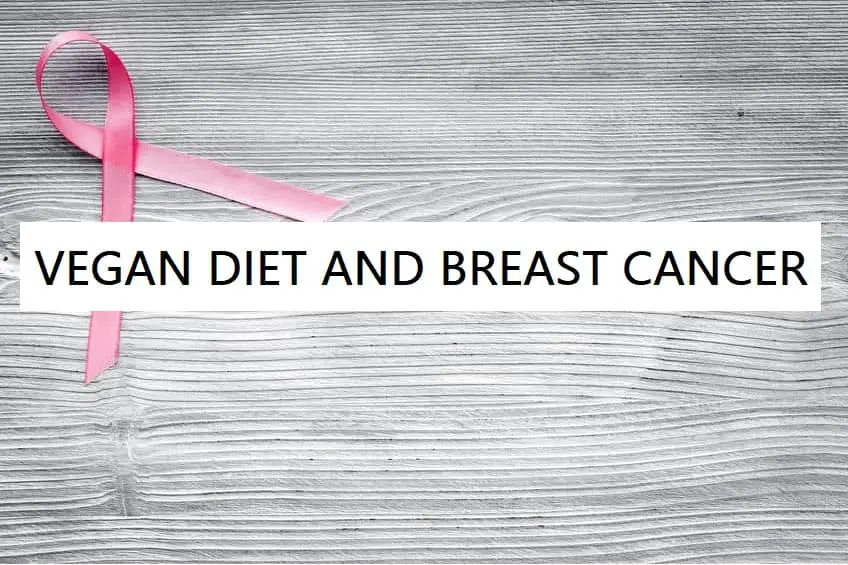If you’ve always wondered whether or not the vegan diet has potential benefits specific to preventing breast cancer, then you’ve come to the right place.
While I’m sure many people are aware that a well-planned vegan diet is anticarcinogenic, I’d imagine that much fewer know that there are numerous ways in which it could be uniquely beneficial for preventing breast cancer.1-53
For example, in the UK Women’s Cohort Study, a meat intake of 50 g per day was associated with both increased premenopausal breast cancer (HR 1.12, 1.02–1.23) and postmenopausal breast cancer (HR 1.10, 1.01–2.20).53
I’ll be publishing an article shortly that’s about the relationship between the vegan diet and cancer more broadly, and it’ll have some basic pathophysiology. But in this article, we’re just going to jump right in, and we’ll cover some physiology here and there as we go.
Going forward keep in mind, that there’s scant epidemiological data on breast cancer outcomes among vegetarian eaters, let alone vegans. However, there’s quite a bit of evidence from mechanistic studies showing benefits of various aspects of a vegan whole food diet on risk factors for breast cancer.
Benefits Related to the Elimination of Animal Products
Vegans Don’t Consume Animal Protein
It’s been known for some time that high circulating levels of IGF-1 are positively associated with the risk of several cancers, including breast cancer. Vegans have relatively low IGF-1 levels compared to meat eaters and even lacto-ovo-vegetarians.1
In recent epidemiologic studies—including prospective data from the Nurses’ Health Study—high plasma IGF-I levels were shown to be independently associated with greater risk of breast cancer among premenopausal women.2
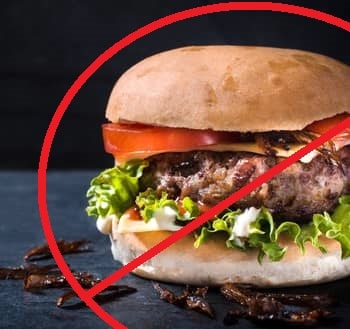
The Animal Protein-IGF1 Connection
Many experts believe IGF-1 levels have something to do with animal protein intake.
Several studies have shown there to be a lower incidence of breast cancer among individuals with a well-balanced vegan diet.3-5 One such study looked at the role of dietary protein in the interrelated disorders of hyperlipidemia, hypertension, and hyperinsulinemia.
In this study Hubbard, et al noted that certain types of dietary protein with specific amino acid ratios can be major secretagogues of insulin—fancy way of saying certain proteins can make you secrete insulin-like crazy.
With high circulating insulin, you get high circulating IGF-1 levels. Which we know from above is a bad thing.
The authors went on to note that cancer of the breast, in particular, appears to have a strong dietary relationship, observing that the incidence of cancer is significantly greater among those on a modern Western diet than among those on vegetarian and vegan diets.3
Vegans Have Low Saturated Fat Intakes
Some of you may be thinking, “I know saturated fat is linked to heart disease, but cancer?” That’s right. In the Nurses Health Study, specifically animal fat was correlated with breast cancer risk.6
The SFA-Breast Cancer Connection
While saturated fatty acids (
Remember that high insulin levels mean high levels of IGF-1. So, if the PUFA/SFA mechanism is true, this would suggest that increased intake of red meat could potentially lead to hyperinsulinemia raising the risk of cancers, including breast.
Vegans Have Less Exposure to Outside Sources of Estrogen
Vegans get less exposure to exogenous estradiol. At least from cattle. Currently, between 70% and 90% of cattle in U.S. feedlots undergo a procedure wherein a hormone implant is inserted below their skin.9
In the US, five hormones are used in industrial animal agriculture:
Hormones naturally occurring in mammals:10
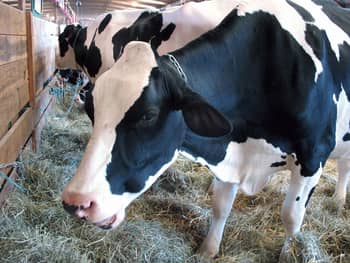
- Estradiol
- Progesterone
- Testosterone
Synthetic hormones
- Zeranol
- Trenbolone acetate
Why? Because it enables factory farms to produce lean meat more efficiently. Cattle who receive these hormones undergo rapid gain of lean body mass. Basically, it makes them “jacked and ripped.”
Now, of the above hormones, estradiol is perhaps the most relevant to the etiology of breast cancer. In humans, increased estradiol levels have long been implicated in the pathophysiology of many cancers, including breast.11
Vegans Consume Little to No Trans Fatty Acids
Because trans fatty acids (TFAs) have now been largely removed due to EU and US FDA regulation, much of the trans fatty acid intake these days comes from red meat.
The TFA from the diet, as well as any stored in fat cells, constitute a major factor in the genesis of many chronic diseases, including cancers. Many studies have demonstrated that TFAs from the diet end up being stored long term in fat cells—and for reasons to be discovered—become a causal factor in the development of cancer in postmenopausal women.12,13
Benefits Related to What the Vegan Diet Emphasizes
High Intakes of Fruits and Veggies
A systematic review was conducted of 206 epidemiologic studies which found that fruits and vegetables were effective in preventing several types of cancer including breast cancer.14
Of the case-control studies (numbering 174 out of the 206) it was found that there was “probable” evidence for a protective role conferred by fruits and vegetables for cancer of the pharynx and oral cavity, colon, pancreas, bladder, and breast.
High Intakes of Whole Grains
A meta-analysis was conducted of 16 prospective studies which showed that for every 10 g/day increment increase of fiber intake, there would be an accompanying 5% reduction in risk of breast cancer.15
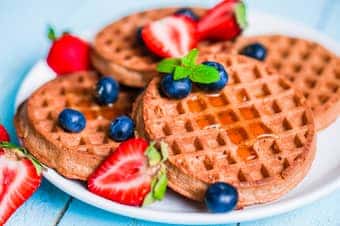
In a study of premenopausal women, higher intakes of fiber, particularly whole grain fiber from cereals, were associated with a lower risk of developing breast cancer compared with lower intakes.16
One recent case-control study involving a group of 250 women with breast cancer—compared to an age-matched group of the same number—yielded fairly shocking results. In this study eating whole grains more than seven times per week was associated with a TWOFOLD lower probability of having breast cancer.17
Whole Grains Are About More Than Just Fiber
So, you might be thinking: how could something as simple as whole grains exert such a powerful effect on breast cancer outcomes?
First of all, don’t underestimate the fiber found in whole grains. And secondly, keep in mind that while much of the above effects are attributed to the fiber, there’s a huge range of protective substances present in whole grains that confer their effects through numerous mechanisms:18
- Hormonal effects
- Antioxidant activity
- Binding carcinogenic substances to be excreted from the body
- Beneficial effects on the gut microbiome
Quick Note: The Importance of Whole Grain Intake During Adolescence for Reducing Breast Cancer Risk
Ensuring higher intakes of whole grain during adolescence and early adulthood may be especially important for breast cancer risk.
Results from the Nurses’ Health Study II (apparently there were several of these things) demonstrated that for every daily intake of 10 grams of fiber during adolescence and young adulthood there would be a corresponding reduction in breast cancer risk by 14%, and 13%, respectively.19
But wait there’s more! The results also suggested that participants eating ~25 g/day during adolescence and young adulthood had a 25% less likelihood of developing breast cancer than those consuming 12 grams of fiber daily.19
And finally, in a systematic review of 40 case-control studies involving 20 cancers, 95% of the studies involved showed a protective effect of whole grains. In this review, whole grain intake was shown to reduce the risk of most cancers by 20–50% with an average risk reduction of 34% in those with high vs. low intakes of whole grains.
The risk of breast specifically, was about 10% lower. Pretty impressive, considering breast tissue doesn’t even come into contact with whole grains—as opposed to the colon, etc.20
Higher Intakes of Soy (Isoflavones)
So, if you’ve read about soy by this point, you may be wondering by now, what the heck are these isoflavones I keep hearing about?
Well, we all know what estrogen is—it’s the hormone released in a woman’s body which regulates her menstrual cycle among other things.
And there are substances referred to as dietary estrogens or phytoestrogens. These estrogen-like compounds are naturally occurring substances found in plants.
There are two types of phytoestrogens:
- Lignans
- Isoflavones—e.g. genistein, ipriflavone, and daidzein
These dietary estrogens are found in soy and other plant foods, and when eaten may affect breast cancer risk.
It should be noted that these compounds exert very weak estrogenic activity at estrogen binding sites compared to other more potent estrogens.21
This is important because estrogen, upon binding to certain receptors in breast tissue can stimulate the development of cancer. Phytoestrogens are similar in structure, enough so that they can bind to estrogen receptors inhibiting the development of breast cancer.22
To the extent that phytoestrogens exert any activity upon binding to receptors, they’re much weaker in doing so. So, estrogen has to compete with these compounds for binding at the receptor which reduces the amount of estrogen binding to breast tissue/causing cancer growth.
Genistein specifically has been shown to be a strong inhibitor of human breast cancer cell growth.23,24
Anyway, soy seems to be quite promising in the prevention of breast cancer. After all, it’s been proposed as an alternative to the anti-estrogen drug tamoxifen for preventing breast cancer in women who are at high-risk.25
Why Is Soy Thought to Be Protective Against Breast Cancer?
Breast cancer is the most common cancer in women. And because genetics is only thought to account for 10% to 15% of the etiology of breast cancer, researchers have been on the lookout for environmental (controllable) risk factors. Studies of East Asian women indicate that those who consume a traditional Asian diet characterized by high consumption of soy products tend to have a low incidence of developing breast cancer.
According to most population studies examining this phenomenon, Asian women with the highest intakes of soy foods have only about 1/5 the rate of breast cancer compared to Western women. Chinese populations who regularly consume soybeans, tofu, and fermented soy products have only about 1/2 the rate of breast cancer, compared with Chinese populations who consume very little soy products.26
Observation 1: Migrant Communities in the US
Over the centuries, various migrant communities have arrived in the US relatively free of chronic health conditions. These migrants travel to the US from low-risk countries, their risk of developing breast cancer (among other cancers) increased to that of US Caucasians after just a few generations.
Observation 2: East Asian Countries
Inquiry into this area started with the observation that breast cancer while common in Western nations is relatively rare in East Asian countries like China and Japan. This observation led researchers to wonder whether or not there may be some protective component of East Asian dietary patterns that may protect against breast cancer.
What’s so effective about the eating patterns common to East Asia? East Asian populations are known to consume large amounts of soy-based foods such as tofu. In fact, tofu is where many East Asian populations get the majority of their protein. While the US is a major exporter of soybeans, actual consumption of soybeans and soybean products among US Caucasians is nigh unheard of.
Breast Cancer Outcomes
Any studies to support the protective role of isoflavones in preventing breast cancer? Yes! Like any other area, there will be some studies showing an effect and others not. But there have been enough studies showing a significant (positive) effect to attract the attention of more and more researchers into this area of inquiry. What I’ll do here is list a few of the more significant findings.
One cohort study and numerous case-control studies have examined the relationship between soy intake and the risk of breast cancer.
One study in Singapore looking at 200 cases of breast cancer in premenopausal women found risk to be reduced by approximately 60% among women with the highest consumption of soy, compared to women with the lowest consumption.27
There was a larger study in Japan, finding women who consumed soy at least three times per week to have an approximately 20% lower risk of breast cancer compared to women with less frequent soy consumption.28
Now, these two studies were focused on premenopausal women.
A study focusing on both pre- and postmenopausal women examined breast cancer risk among Asian women in the US.
The study involved 597 breast cancer cases and found a 15% lower risk of breast cancer in postmenopausal as well as premenopausal women.29
Higher Intakes of Nuts and Seeds (Lignans)
Remember the mentioning of lignans above? Lignans are a type of phytoestrogens.
They are highly branched polymers. In chemistry, polymers are compounds with a large number of small units strung together to make a compound. Anyway, this polymer is made of phenol units (another organic chemistry term) bound together tightly.
These molecules form the structural components of plants and are thought to attach to other noncellulose complex carbohydrates found in plant cell walls.
How Are Lignans Thought to Help Prevent Breast Cancer?
In short, plant lignans are turned into the mammalian lignans enterodiol and enterolactone by healthy gut bacteria in the colon.30
Now, these compounds are considered insoluble in water and thus are generally considered to be poorly fermented by gut bacteria.
However, some studies, demonstrate that the gut flora metabolize these compounds to some extent, and in doing so form a weak phytoestrogen.31
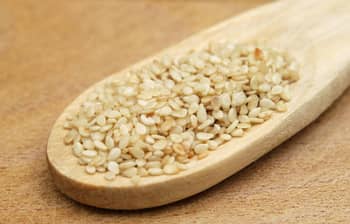
Upon fermentation, lignan metabolites are formed which are structurally very similar to estrogens. Because they’re similar in structure, they can bind to estrogen receptors and inhibit the development of estrogen-stimulated breast cancer.22
These nutritious compounds are largely found in seeds and grains:
- The seeds and stems of fruits and vegetables. Think fruits with edible seeds like strawberries.
- Sometimes, as in the case with flaxseed, lignins are actually formed once the seed is ground and exposed to moisture.
- Oilseeds, like sesame seed, are packed full of lignans.32
- Wheat—specifically within the bran layer of cereal grains
Higher Intakes of Fruits and Vegetables
We’ll touch on specific nutrients below, but to start with: the effects of fruit and vegetable consumption on hormone-sensitive cancers (such as breast cancer) have long been studied. One case-control study found a strong inverse relationship between breast cancer risk and total vegetable intake in premenopausal women.33
Among women with the highest intake of vegetables, a reduction in risk of about 54% was seen compared with women having the lowest intake.
Another study found fruit and vegetable consumption to be independently associated with marked reductions in breast cancer incidence.34
In this study, those with a daily intake of 4-5 servings of vegetables were shown to have a 46% lower risk of developing breast cancer, compared women consuming 2 or fewer servings per day. As for fruit intake, those consuming 6 or more servings per day had a 35% lower breast cancer risk than women with an intake of fewer than 2 servings per day.
Higher Carotenoid Intake
These are the fat-soluble yellow/orange/red pigments found in so a lot of vegetables, and some fruits. They can be on the orange side (pumpkin, carrots, butternut squash, persimmons), or on the red side (tomatoes). They’re also abundant in dark-green leafy vegetables, it’s just that with greens, chlorophyll is the dominant pigment.
More than 600 carotenoids exist in nature. Some of the more common ones are:
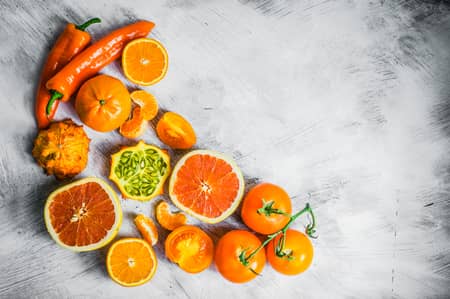
- α-carotene
- β-carotene
- Lutein
- β-cryptoxanthin
- Zeaxanthin
- Lycopene
What’s the Carotenoid-Breast Cancer Connection?
Carotenoids have long been thought to protect against carcinogenesis by preventing DNA damage. It’s thought that they likely prevent reactive oxygen species (ROS) from inducing the initial DNA damage that’s the first crucial step in the carcinogenesis process.35-37
Some studies suggest that lycopene may have a function in protection against breast and cervix cancers.38,39
There are a few other mechanisms depending on which carotenoids we’re talking about. I’ll probably touch on these when I write an in-depth article on carotenoids.
Lower Incidence of Obesity Among Vegans
We’ve known for a while that vegans have the lowest BMI of any other population.40
According to VanItallie et al, among the various metabolic diseases and abnormalities linked to obesity include glucose intolerance, insulin resistance, hyperinsulinemia, type 2 diabetes, heart disease, hypertension, stroke, gout, cholecystitis, obstructive sleep apnea, and finally… breast cancer.41
Many studies back up the link between obesity and breast cancer, especially in postmenopausal women. Even BMI increases (regardless of obesity status) influence breast cancer risk. In one study, a 5-unit BMI increase was associated with a 12% increase in breast cancer risk.42
Another study showed that among postmenopausal women, those obese individuals have a 20-40% elevated in risk of having breast cancer compared with women in the normal-weight category.43
Observations consistently indicate that increased body weight and obesity are risk factors for cancer, especially that of the colon, endometrium, prostate, and breast, whereas higher levels of physical activity are protective in the prevention of the same cancers.44
What’s the Obesity-Breast Cancer Connection?
According to François and fellow authors of Plant-based Diets in Health and Disease Prevention, obesity after menopause increases the risk of breast cancer, likely because excess body fat causes an increase in circulating levels of estrogens.45
Interestingly, for this reason, obesity is also considered a risk factor for breast cancer in men.46
Later Onset of Menarche Among Vegan Adolescents
Among the many risk factors for breast cancer include early onset of menarche.47-49
In one analysis of the Seventh Day Adventist study mentioned above, Sabaté et al noted that SDA prepubertal girls tended, on average, to be slightly shorter than controls. The difference was about 3cm which was significant enough for the authors to suggest that SDA vegetarian girls have a later pubertal onset.
Similar findings are supported by other studies. Two studies, in particular, provide evidence for a marked association between age of menarche and a meat-free diet.50,51
What’s the Diet-Menarche Connection?
Yet again, it has to do with estrogen. As you’ll see in the section on soy, phytoestrogens interact with human physiology in a way that seems to be protective against developing breast cancer. Part of the protective role is thought to have to do with the effect of soy products on the menstrual cycle—for both pre- and postpubescent women.
One study of premenopausal women revealed several potentially beneficial changes throughout the menstrual cycle of the participants. Regular consumers of soy protein experienced a lengthening of the follicular phase of their cycles by 2 to 3 days.52
Why is this important? Because hormone levels are usually sky high during the luteal phase, which results in breast cell proliferation. So, if a diet lengthens the follicular phase it’s possible that it could make for fewer luteal phases, in the long run, reducing breast cancer risk.52
References
- Endogenous Hormones and Breast Cancer Collaborative Group, Key, T.J., Appleby, P.N., Reeves, G.K., Roddam, A.W., 2010. Insulin-like growth factor 1 (IGF1), IGF binding protein 3 (IGFBP3), and breast cancer risk: pooled individual data analysis of 17 prospective studies. Lancet Oncol. 11, 530–542.
https://www.ncbi.nlm.nih.gov/pubmed/20472501 - Giovannucci, E. Insulin-like growth factor-I and binding protein-3 and risk of cancer. Horm Res., 51 Suppl 3:34-41, 1999.
https://www.ncbi.nlm.nih.gov/pubmed/10592442 - Hubbard, R.W., Mejia, M.S., and Horning, M.C. The potential of diet to alter disease processes. Nutr. Res., 14, 12, 1853, 1994.
- Walter, P. Effects of vegetarian diets on aging and longevity. Nutr. Rev., 55, S61, 1990.
https://www.ncbi.nlm.nih.gov/pubmed/9155227 - Key, T.J.A., Thorogood, M., Appleby, P.N., and Burr, M.I. Dietary habits and mortality in 11,000 vegetarians and health conscious people: results of a 17- year follow up. BMJ, 313, 775, 1996.
https://www.ncbi.nlm.nih.gov/pubmed/8842068 - Flagg, E. W., Coates, R. J., and Greenberg, R. S. Epidemiologic studies of antioxidants and cancer in humans. J. Am. Coll. Nutr., 14, 419, 1995.
https://www.ncbi.nlm.nih.gov/pubmed/8522720 - Field, C.J., Ryan, E.A., Thomson, A.B., and Clandinin, M.T. Diet fat composition alters membrane phospholipid composition, insulin binding, and glucose metabolism in adipocytes from control and diabetic animals. J. Biol. Chem., 265(19):11143-50, Jul 5, 1990.
https://www.ncbi.nlm.nih.gov/pubmed/2113530 - Joannic, J.L., Auboiron, S., Raison, J., Basdevant, A., Bornet, F., and Guy-Grand, B. How the degree of unsaturation of dietary fatty acids influences the glucose and insulin responses to different carbohydrates in mixed meals. Am. J. Clin. Nutr., 65(5):1427-33, May 1997.
https://www.ncbi.nlm.nih.gov/pubmed/9129472 - USDA, Meat Safety and Wholesomeness, Unit 2. In: The Livestock Industry: Production of Lean, Wholesome Meat for the Consumer, Module 1 of The Consumer’s Choice Meat Education Program. Produced by the U.S. Department of Agriculture, Extension Service.
- Hanrahan, C. The EU’s Ban on Hormone-Treated Meat. Congressional Research Service Report RS20142, Washington D.C., 1999.
- Liehr, J.G. Is estradiol a genotoxic mutagenic carcinogen? Endocr. Rev., 21(1):40- 54, Feb 2000.
https://www.ncbi.nlm.nih.gov/pubmed/10696569 - Koleltzko, B. Trans fatty acids may impair biosynthesis of long-chain polyunsaturates and growth in man. Acta Paediatr., 81, 302, 1992.
https://www.ncbi.nlm.nih.gov/pubmed/1606388 - Kohlmeier, L., Simonsen, N., Veer, P.V., Strain, J.J., Martin-Moreno, J.M., Margolin, B., Huttunen, J.K., Navajas, F.C., Martin, B.C., Alwin, M.T., Kardinall, F.M., and Kok, F.J. Adipose tissue trans fatty acids and breast cancer in the European community multicenter study on antioxidants, myocardial infarction, and breast cancer. Cancer Epid. Biomarkers and Prev., 6, 705, 1997.
https://www.ncbi.nlm.nih.gov/pubmed/9298578 - Steinmetz, K. and Potter, J.D. Vegetables, fruit, and cancer prevention: A review. J. Am Dietetic Assoc., 96:1027-1039, 1996.
https://www.ncbi.nlm.nih.gov/pubmed/8841165 - Aune, D., Chan, D.S., Greenwood, D.C., et al., 2012. Dietary fiber and breast cancer risk: a systematic review and meta-analysis of prospective studies. Ann. Oncol. 23 (6), 1394–1402.
https://www.ncbi.nlm.nih.gov/pubmed/22234738 - Cade, J.E., Burley, V.J., Greenwood, D.C., 2007. Dietary fibre and risk of breast cancer in the UK Women’s Cohort Study. Int. J. Epidemiol. 36 (2), 431–438.
- Mourouti, N., Kontogianni, M.D., Papavagelis, C., et al., 2016. Whole grain consumption and breast cancer: a case-control study in women. J. Am. Coll. Nutr. 35 (2), 143–149.
- Slavin, J., Martini, M.C., Jacobs, D.R., and Marquant, L. Plausible mechanisms for the protectiveness of whole grains. Am. J. Clin. Nutr., 70 (Suppl): 459S-63S, 1999.
- Farvid, M.S., Eliassen, A.H., Cho, E., et al., 2016. Dietary fiber intake in young adults and breast cancer risk. Pediatrics 137 (3), 1–11.
- Jacobs, D.R., Jr., Marquart, L., Slavin, J., and Kushi, L.H. Whole-grain intake and cancer: an expanded review and meta-analysis. Nutr. Cancer., 30: 85, 1998.
- Messina M. and Barnes, S. The role of soy products in reducing risk of cancer. J. Natl. Cancer Inst., 83:541-546, 1991.
- Hirano, T., Fukuoka, K., Oka, K., Naito, T., Hosaka, K., Mitsuhashi, H., and Matsumoto, Y. Antiproliferative activity of mammalian lignan derivatives against the human breast carcinoma cell line, ZR-75-1. Cancer Invest., 8: 595, 1990.
- Shen, F., Xue, X., and Weber, G. Tamoxifen and genistein synergistically downregulate signal transduction and proliferation in estrogen receptor-negative human breast carcinoma MDA-MB-435 cells. Anticancer Res., 19, 1657, 1999.
- Zava, D.T. and Duwe, G. Estrogenic and antiproliferative properties of genistein and other flavonoids in human breast cancer cells in vitro. Nutr. Cancer., 27, 31, 1997.
- Setchell, K.D.R. Phytoestrogens: Biochemistry, physiology, and implications for human health of soy isoflavones. Am. J. Clin. Nutr.., 68: 1333S, 1998.
- Messina, M.J., Persky, V., Setchell, K.D., and Barnes, S. Soy intake and cancer risk: a review of the in vitro and in vivo data. Nutr. Cancer., 21: 113, 1994.
- Lee, H.P., Gourley, L., Duffy, S.W., Esteve, J., and Day, N.E. Dietary effects on breast-cancer risk in Singapore. Lancet, 337:1197-2000, 1991.
- Hirose, K., Tajima, K., Hamajima, N., Inoue, M., Takezaki, T., Kurisha, T., Yosida, M., and Tokudome, S. A large-scale, hospital-based case-control study of risk factors of breast cancer according to menopausal status. Jpn. J. Cancer Res., 86:146-154, 1995.
- Wu, A.H., Ziegler, R.G., and Horn-Ross, P.L., et al. Tofu and risk of breast cancer in Asian-Americans. Cancer Epidemiol. Biomarkers Prevention, 5:901- 906, 1995.
- Thompson, L.U., Robb, P., Serraino, M., and Cheung, F. Mammalian lignan production from various foods. Nutr. Cancer., 16: 43, 1991.
- Begum AN, Nicolle C, Mila I, et al. Dietary lignins are precursors of mammalian lignans in rats. J Nutr. 2004; 134:120–27.
- Mazur, W. Phytoestrogen content in foods. Baillieres Clin. Endocrinol. Metab., 12: 729, 1998.
- Freudenheim, J.L., Marshall, J.R., Vena, J.E., Laughlin, R., Brasure, J.R., Swanson, M.K., Nemoto, T., and Graham, S. Premenopausal breast cancer risk and intake of vegetables, fruits, and related nutrients. J. Natl. Cancer Inst., 88: 340, 1996.
- Trichopoulou, A., Katsouyanni, K., Stuver, S., Tzala, L., Gnardellis, C., Rimm, E., and Trichopoulos, D. Consumption of olive oil and specific food groups in relation to breast cancer risk in Greece. J. Natl. Cancer Inst., 87: 110, 1995.
- Steinmetz KA, Potter JD. Vegetables, fruit, and cancer. II. Mechanisms. Cancer Causes Control 1991;2:427–42
- Rao AV, Rao LG. Carotenoids and human health. Pharmacol Res 2007;55:207–16
- Frei B. Reactive oxygen species and antioxidant vitamins: mechanisms of action. Am J Med 1994;97(3A):5S–13S; discussion 22S–8S
- Dorgan, J.F., Sowell, A., Swanson, C.A., Potischman, N., Miller, R., Schussler, N., and Stephenson, H.E., Jr. Relationships of serum carotenoids, retinol, alphatocopherol, and selenium with breast cancer risk: results from a prospective study in Columbia, Missouri (United States). Cancer Causes Control, 9: 89, 1998.
- Kantesky, P.A., Gammon, M.D., Mandelblatt, J., Zhang, Z.F., Ramsey, E., Dnistrian, A., Norkus, E.P., and Wright, T.C., Jr. Dietary intake and blood levels of lycopene: association with cervical dysplasia among non-Hispanic, black women. Nutr. Cancer., 31: 31, 1998.
- Serena, Terry B, Ru Y, et al. Type of Vegetarian Diet, Body Weight, and Prevalence of Type 2 Diabetes. Diabetes Care. 2009;32(5):791–796
- VanItallie, T.B. and Lew, E.A. Estimation of the effect of obesity on health and longevity: A perspective for the physician. In: Obesity Theory and Treatment. Stunkard and Wadden (Eds.), Raven Press, New York, 1993.
- Renehan AG, Tyson M, Egger M, Heller RF, Zwahlen M. Body-mass index and incidence of cancer: a systematic review and meta-analysis of prospective observational studies. Lancet 2008; 371(9612):569-578.
- Munsell MF, Sprague BL, Berry DA, Chisholm G, Trentham-Dietz A. Body mass index and breast cancer risk according to postmenopausal estrogen-progestin use and hormone receptor status. Epidemiologic Reviews 2014; 36:114-136.
- Food, nutrition, and the prevention of cancer: a global perspective. Washington, D.C.: World Cancer Research Fund/American Institute for Cancer Research, 1997.
- Vegetarian and Plant-based Diets in Health and Disease Prevention François Mariotti – Elsevier Academic Press – 2017
- Brinton LA, Cook MB, McCormack V, et al. Anthropometric and hormonal risk factors for male breast cancer: male breast cancer pooling project results. Journal of the National Cancer Institute 2014; 106(3):djt465.
- Miller, A. B. and Bulbrook, R. O. The epidemiology and etiology of breast cancer. New Engl. J. Med., 303: 1246, 1980.
- Kelsey, J. L. and Hildreth, N. G. Breast and Gynecological Cancer Epidemiology. CRC, Boca Raton, 1983.
- De Waard, F., and Trichopoulos, D.A. A unifying concept of the aetiology of breast cancer. Int. J. Cancer, 41: 666, 1988.
- Sabaté, J., Llorca, M. C., and Sanchez, A. Lower height of lacto-ovo-vegetarian girls at preadolescence: an indicator of physical maturation delay? J. Am. Diet. Assoc., 1263: 1992.
- Kissinger, D. G. and Sanchez, A. The association of dietary factors with the age of menarche. Nutr. Res., 7: 471, 1987.
- Cassidy, A., Bingham, S., and Setchell, K.D. Biological effects of a diet of soy protein rich in isoflavones on the menstrual cycle of premenopausal women. Am. J. Clin. Nutr., 6: 333, 1994.
- Taylor EF, Burley VJ, Greenwood DC, Cade JE. 2007. Meat consumption and risk of breast cancer in the UK Women’s Cohort Study. Br J Cancer 96(7):1139–46.

